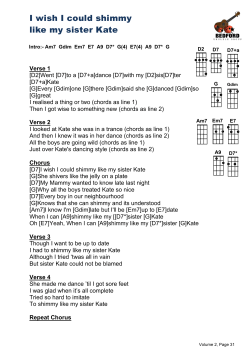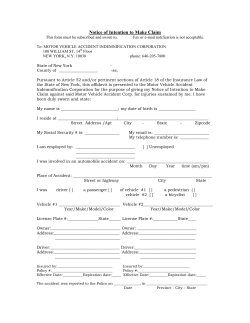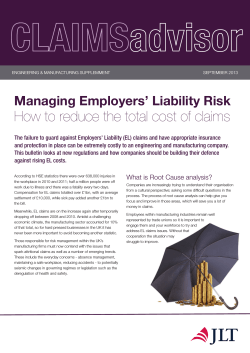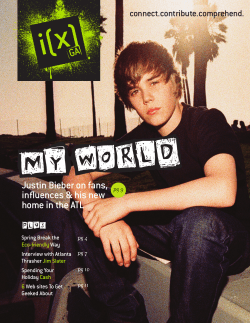
YOUR VOICE Slow pace to
YOURVOICE edition October 2014 Slow pace to recovery Music that’s worth the wait When Kate met Bieber Finding a new pace 99 days after MY accident Before the accident, I worked as a pastry cook at Gillies in Bendigo where I live with my family. I had worked there for most of my life and was used to the early mornings. I’m really into health and wellbeing, which all started when I was 17 and took up running. I used to run about 80 kilometres a week until I was 42. I found at that age you start to get a few little niggles when you push yourself, so I switched over to a bike. I was probably doing between 300 and 350 kilometres a week up to the point of my accident. In the lead up to the accident I’d spent a couple of days at home looking after my wife because she’d been quite ill and I had to take her to hospital. She actually spoke to me the night before the accident and said, ‘Just be careful when you’re out. I just have this feeling’. On March 19, 2010 – the day of the accident – I got up at my usual time to go to work at 4:15 am. I’d ridden about seven kilometres and was checking behind me to make sure I was safe. A couple of trucks drove past and then I saw a third set of lights on a smaller vehicle approaching. All of a sudden the lights changed direction and two seconds later I was hit by a postal van and thrown about eight to 10 metres. I landed on my knees facing the vehicle and I remember thinking, 02 Share your story by emailing us at intac@tac.vic.gov.au ‘My bike’s broken and I’m going to be late for work today’. I had no idea how seriously injured I was. The next three to four days in hospital were pretty much a blur. I was on quite strong pain relief, ketamines and morphine. I had multiple rib fractures, a broken right shoulder blade, broken teeth, and a closed head injury, I lost a lot of skin on my back and had cuts and sprains on my feet from being ejected out of the bike clips. But the most serious injuries were in my spine where I had three compressed fractures in the middle area and two burst fractures in the lower back. My first memory when I woke up in the hospital was seeing the face of the orthopaedic surgeon. I told her I was frightened I was going to be paralysed. I remember her hand grabbing my face and she looked me in the eyes and she said, ‘Don’t worry I repair four spines a week. You’re going to be fine’. I was in surgery for five hours. Afterwards, the doctors discovered they’d left some swabs in my chest so I spent a further two hours in surgery while they removed them. Going back to work was the final jigsaw piece of my recovery. When you’re focussed on something else other than your own situation, the last bits of your body heal on their own. doesn’t have really good health and had to look after me as if I was a baby. I was basically on my back in a back brace and not able to do anything for eight months. For the first year, all I did was sleep for 18 hours a day. I had to wear a back brace for three months. I had lung problems for quite a long time after that because the doctors had to collapse my left lung to get the swabs out. Being an athlete all my life, I was sure the more active I was, the quicker I was going to recover. But it only made things worse. I had a couple of really nasty flare-ups that required multiple cortisone shots in all the muscles around the burst fractures in my spine. I had to take a massive amount of anti-inflammatories and I couldn’t get comfortable in bed, That was a really down time. For the first 18 months after the accident, I was cross and angry. The driver who hit me was actually a neighbour three or four doors down from me. Most days I would see this fellow drive past my house and he wouldn’t even acknowledge me. He didn’t even come over to apologise. He told the police officers he just lost concentration. Too many people are injured by drivers not concentrating or using mobile phones. Causing serious injury and harm to others because of inattention on the roads isn’t an excuse. My wife and two boys, who are 22 and 18, were obviously quite distressed. Particularly my wife, who The TAC started making fortnightly payments to supplement the fact that I couldn’t work, which was fantastic. I remember when I had a nasty muscle flare-up they paid for me to get a couple of soft supportive back braces. They still pay for a delivery of firewood, which I used to chop before the accident. When I was back on my feet I decided I was going to set goals. My three major goals were getting a job, being pain-free and taking a very short run on a soft surface. I just kept exercising to achieve those goals. Walking was difficult for the first couple of years. I would say it probably took two and a half years to be able to walk properly like everyone else. I also started going the pool doing a little bit of freestyle swimming. Within about six months I was swimming about three kilometres and walking about three kilometres. But after 25 months I still couldn’t walk really well and I was quite unstable. For example, I’d wash the car and I’d be all wobbly like I’d been drinking. The doctor referred me to a clinical pilates specialist. I started doing pilates core exercises and I bought a pilates machine to use at home. I started doing about half an hour a day on that. It helped me get to a place where I’m 100 per cent pain-free most of the time. Getting a job was a really fantastic feeling. I work as an occupational health and safety officer at a local carpet company. I started working 25 hours a week and gradually built up to 35 hours. Going back to work was the final jigsaw piece of my recovery. When you’re focussed on something else other than your own situation, the last bits of your body heal on their own. My last goal was going on for a run. I went to Apollo Bay 999 days after the accident and walked down to the beach near the water’s edge. I took a few steps and I went for a jog. That was a real achievement. Pilates for recovery Pilates is a unique system of rehabilitative and conditioning exercise created by Joseph Pilates in the early 1900’s. Joseph studied yoga and the rigorous regimens of the ancient Greeks to improve his own health. During World War One he continued to develop and use his work to help rehabilitate wounded people. The premise of pilates is that a few well done exercises are more effective than many sloppy repetitions. The emphasis is on quality rather than the quantity of movement. Correctly executed movements become habit and contribute to optimum physical strength. These basic tenets have proven over the years that pilates is effective for people of all fitness levels in enhancing life by building core strength, reducing stress and rehabilitating injuries. 03 Music that’s worth the wait The Heist eGallery is an online exhibition space showcasing a wide range of visual artwork. The gallery opened during Mental Health Week in 2011. Heist was created in response to barriers artists with a disability face in getting their artwork exhibited. Heist’s purpose is to provide professional development opportunities for artists with a disability and see their work reach a wider audience. The gallery is run by Arts Access Victoria (AAV). Established in 1974, AAV aims to build strong community based partnerships to grow and support arts programs for people with a disability. Pauline Petrus photograph courtesy of Kelly at Wilde Photography Waiting on hold is a part of dealing with big business and can sometimes make or break your day. An auditory nightmare of repetitive commercials or taglines, or a radio just slightly off its station can make waiting on hold more than painful, particularly if you’re already stressed and under pressure. Accomplished musician, Pauline Petrus, is making sure that people waiting on hold when they ring the Transport Accident Commission (TAC) are soothed by a relaxing and meditative piano solo. Pauline responded to call out in Your Voice to submit original music for the TAC’s telephone system. She is no stranger to the TAC after being injured in three separate car crashes which left her unable to continue teaching music. But Pauline is still able to enjoy what she loves most, composing and performing original tracks. Pauline said: “I feel I was, and still am, lucky to have the enjoyment of music as an interest. Plus playing and composing music gave me an outlet at those trying times during rehabilitation.” Art can have a significant impact on the lives of people with disabilities. Many people find meaning and inspiration in art. It can also provide healing and tranquillity. Julie Reid, long-time AAV artist and Heist exhibitionist said, “Art allows me to give voice to things that words often fail, it allows other ideas to enter and reconnects me with those parts of myself I thought I’d lost”. Get your caffeine f fi ix close to the beach If you live near Frankston and are looking for a great place to catch up with friends for a coffee, check out CoffeeHead II. The café is part of the Quest building in Frankston, close to the beach and has a wheelchair-friendly side entrance and toilets close by. CoffeeHead II has good coffee and delicious food that’s not too expensive. The menu includes meals from different countries, like Japan, as well as Australian food and staff too. 04 Welcome to your new-look YOUR VOICE This year’s newsletter will feature shorter stories, more updates and community activities which are more relevant to you. You can help us make the newsletter better by sending us your stories or sharing feedback. Simply email intac@tac.vic.gov.au When Kate met Bieber Dreams came true for Justin Bieber fan, Kate O’Neill, when he performed an intimate concert for her and her friends. Courtesy VEVO. An “impossible dream” came true for Justin Bieber fan, Kate O’Neill, when the Canadian singer performed an intimate concert for her and her friends. Kate was injured in a car crash which left her with broken ribs, a fractured spine, internal bleeding and lacerations to her internal organs. Kate was a passenger in a car that was overtaking a truck, and swerved to miss a car heading in the opposite direction, hitting a tree. The 19-year-old had tickets to all of Justin Bieber’s ‘Believe’ tour dates in Australia but was unable to see her idol because she was recovering in hospital. Kate’s friends launched a social media campaign called #JustinMeetKate to get ‘Biebs’ to perform a concert for her. The Herald Sun highlighted the campaign after it trended at the top of tweets and the popstar tweeted a link to the newspaper’s article about Kate’s efforts to meet him, writing “special girl. been hearing a lot about her. Hmm.” Two days after the Tweet, Kate was chauffeured from Epworth Rehabilitation to a Docklands studio for an acoustic gig with Biebs and about 50 other fans. Justin, 19, Instagrammed several sweet pictures of the new pals, writing, “Me and my girl Kate :) she’s so strong.” Kate said: “I’m just so grateful to everyone who made it happen; Justin, Justin’s crew, VEVO, Hot Hits, and everyone who tweeted it.” “It’s given me the power to soldier on and push through my recovery, I’m so happy I got to see him.” Kate’s mum, Jacinta, said meeting Justin two weeks after the accident gave Kate a positive focus in the days after her accident. Kate said: “It was like the best day of my life. I’ve never cried so much ever.” Justin even serenaded Kate during “One Less Lonely Girl,” which was what she described as her “impossible dream”. 05 Sensory gardens Sensory gardens are designed to be accessible and enjoyable to visitors, including people with a disability. These gardens provide individual and combined sensory opportunities that visitors might not normally experience. A sensory garden can contain scented and edible plants, sculptures and sculpted handrails, water features, textured touch-pads, magnifying-glass screens, braille and audio induction loop descriptions. Many sensory gardens provide experience for multiple senses; those specialising in scent are sometimes called scented gardens, those specialising Other sensory gardens Sensory gardens open to the public in Victoria: he Royal Botanic Gardens, Melbourne T (Sensory gardens include the Grey Garden, the Herb Garden and the Children’s Garden) The Royal Botanic Gardens, Cranbourne Mambourin Sensory Gardens, Werribee in music and sound are sound gardens where the equipment doubles up to provides an enhanced opportunity for strategic developmental, learning and educational outcomes. Sensory Gardens usually have an enhanced infrastructure to permit wheelchair access and meet other accessibility concerns. The design and layout provides a stimulating journey through the senses, heightening awareness, and bringing positive learning experiences. Media courses for people with a disability Disability Media Australia (DMA), a not-for-profit organisation advancing the rights and inclusion of people with disabilities in Australia, has a range of media courses available for people. DMA courses ensure people with a disability are seen and heard through the production of diverse and entertaining television, radio and film content; sharing their stories and talents. Courses include Contact us Telephone 8.30am to 5.30pm, Monday to Friday 1300 654 329 (local call) 1800 332 556 (toll-free outside the Melbourne metropolitan area) Address 60 Brougham Street Geelong VIC 3220 • ‘Media Training for Students with Disabilities’, • ‘A – Z of Podcasting’ and • ‘TV Skills – on the job’. Mailing address TAC GPO Box 742 Melbourne VIC 3220 There are 12-month courses available for people who have funding packages to complete them. Website www.tac.vic.gov.au Find out more at http://disabilitymedia.org.au/us Empower is published by the Transport Accident Commission. © Copyright Transport Accident Commission, 2014 06 Share your story by emailing us at intac@tac.vic.gov.au
© Copyright 2025









